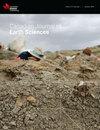加拿大火山带的地震活动和地震监测
IF 1.6
4区 地球科学
Q3 GEOSCIENCES, MULTIDISCIPLINARY
引用次数: 1
摘要
加拿大最近的活火山带(例如,过去一万年的火山喷发)都位于加拿大西部的构造板块边界地区,从不列颠哥伦比亚省南部延伸到育空/阿拉斯加边境,绵延2000多公里。在本文中,我们描述了这些火山带及其附近的地震监测历史以及过去和现在的地震活动检测阈值。加拿大最近的活火山是Tseax Cone(约1700年)和Lava Forks(1800年),它们都位于不列颠哥伦比亚省西北部。然而,自1898年(不列颠哥伦比亚省维多利亚)和1904年(阿拉斯加州锡特卡)部署最早的地震仪以来,加拿大没有发生过火山喷发。地震探测水平已从1900年的M~7级降至今天的M~0 ~ 1级(在许多地区),目前在不列颠哥伦比亚省和育空地区有120多个地震台站在运行,其中包括火山带内的20多个地震台站。最近一次由加拿大火山带引起的重大地震活动是2007年纳兹科锥地震群,在大约两个月的时间里,这里发生了近1000次微小地震。这些都是地壳底部附近的深地震(~30公里),显示出岩浆注入地壳深处的模式。在此之前,在阿纳希姆火山带的西端,从1940年到1943年发生了40多次有震感的地震。我们提供了这两个群和其他地震活动的总结,以及一些最近和正在进行的关于加拿大一些火山带地震活动的研究和火山地震监测的新进展(包括使用分布式声学传感)。本文章由计算机程序翻译,如有差异,请以英文原文为准。
Seismicity and Seismic Monitoring of Canada's Volcanic Zones
Canada’s recently active volcanic zones (e.g., eruptions during the past 10,000 years) are all located along the tectonic plate boundary region of western Canada, extending for more than 2000 km from southern British Columbia to the Yukon/Alaska border. In this article, we describe the history of seismic monitoring in and near these volcanic zones and the past and current seismicity detection thresholds. The most recently active volcanoes in Canada are Tseax Cone (~1700) and Lava Forks (1800’s), both in northwestern British Columbia. However, no eruptions have occurred in Canada since the deployment of the earliest seismographs in 1898 (Victoria, BC) and 1904 (Sitka, Alaska). Seismic detection levels have decreased from M~7 in 1900 to M~0-1 (in many regions) today, with more than 120 seismic stations currently operating in British Columbia and the Yukon, including ~20 seismic stations within the volcanic zones. The most recent significant seismic activity attributed to volcanic zones in Canada is the 2007 Nazko Cone earthquake swarm when nearly 1000 tiny (M<3) earthquakes occurred here over the span of about two months. These were all deep earthquakes (~30 km) near the base of the crust and showed the patterns expected from an injection of magma deep into the crust. Prior to that, at the western end of the Anahim Volcanic Belt, more than 40 felt earthquakes occurred from 1940-1943. We provide a summary of these two swarms and other seismicity as well as some recent and ongoing studies into seismicity at some of Canada’s volcanic zones and new developments in seismic monitoring of volcanoes (including using distributed acoustic sensing).
求助全文
通过发布文献求助,成功后即可免费获取论文全文。
去求助
来源期刊

Canadian Journal of Earth Sciences
地学-地球科学综合
CiteScore
2.80
自引率
7.10%
发文量
66
审稿时长
6-12 weeks
期刊介绍:
The Canadian Journal of Earth Sciences reports current research in climate and environmental geoscience; geoarchaeology and forensic geoscience; geochronology and geochemistry; geophysics; GIS and geomatics; hydrology; mineralogy and petrology; mining and engineering geology; ore deposits and economic geology; paleontology, petroleum geology and basin analysis; physical geography and Quaternary geoscience; planetary geoscience; sedimentology and stratigraphy; soil sciences; and structural geology and tectonics. It also publishes special issues that focus on information and studies about a particular segment of earth sciences.
 求助内容:
求助内容: 应助结果提醒方式:
应助结果提醒方式:


